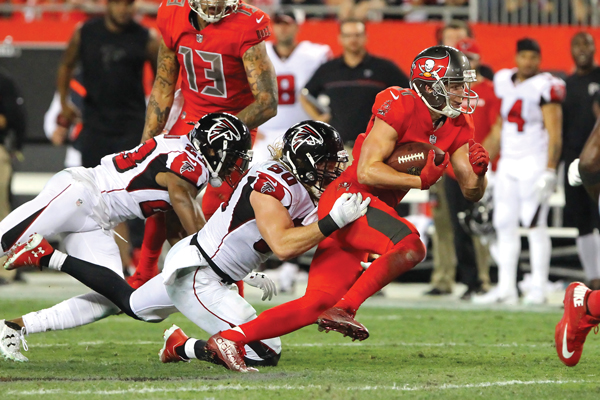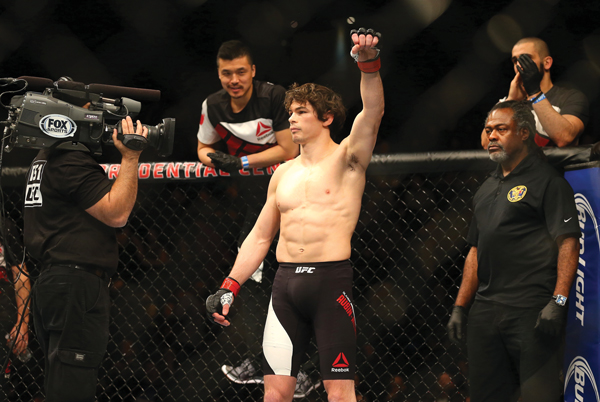L
ast year, when I asked eight sports business types to identify the story they are following the closest, half focused on the NFL’s
Twitter deal. By comparison, this season’s NFL-
Amazon deal seems almost humdrum. Streaming NFL games? Been there, done that. Twitter questions have been replaced by uncertainty around how traditional media companies will respond to disrupters.
One story that will pique my interest this fall is how Nielsen’s new out-of-home measurement is received. The question of whether ad buyers will buy into it remains, but it’s easy to see why networks like it. So far, out-of-home numbers are gaudy. For example, out-of-home ratings for ABC’s NBA Finals provided an 11 percent lift over traditional at-home ratings and an 18 percent lift in the 18-34 demo. The story was the same for ESPN’s Jeff Horn-Manny Pacquiao boxing match. Out-of-home showed a 16 percent lift overall and a 23 percent lift in the 18-34 demo.
 |
NFL ratings will get plenty of scrutiny as the new season begins. Will they rebound?
GETTY IMAGES |
Here’s what others in the industry say they are watching:
■ Whither ESPN?
What am I watching the rest of the year? The same thing I was watching two years ago, and last year, and will be watching next year and the year after that: ESPN and its struggle to adapt to a world where not everyone pays for ESPN. Sorry for people who want a different narrative, but ESPN is the biggest story in the sports business. If that stops being the case, it means the sports business has undergone radical change. On tap this year: What exactly will be in the OTT product ESPN launches in 2018 (if it launches), and what happens when everyone is underwhelmed by that product? Bonus story for 2017: See if the NFL defines “mobile” broadly as it begins to discuss its upcoming mobile deal, leaving room for Silicon Valley (and Seattle) to compete with carriers for that one.
— Peter Kafka, senior editor, Re/code
■ All eyes on the octagon
I’ll be interested to see how the UFC media rights negotiations play out. The negotiating process and the deal that emerges are likely to shed light on a number of important trends and questions impacting the industry, including: The emergence of “digital” bidders, the appetite for major properties among traditional networks as subscriber numbers continue to decline, the role of property-owned OTT platforms (Fight Pass), and the treatment and valuation of new technologies such as VR. For a lot of good reasons, I would expect the UFC to see a significant increase but will have an eye on where the increase comes from, the magnitude of the increase, how it relates to what’s been projected, the interplay among PPV, Fight Pass and third-party rights deals, and the implications of any changes in the allocation of fights among these platforms. Finally, it will be interesting to see how the deal impacts the manner in which the WME-IMG acquisition of UFC is perceived.
— Doug Perlman, CEO, Sports Media Advisors
■ The ratings game
The sports business story I am following closely is NFL TV ratings. The narrative surrounding NFL TV ratings last year presented a significant and sustained PR challenge to the league and its television and business partners. Prior to last season, expectations had been that NFL ratings would continue to increase. Last season’s ratings declines presented unique PR issues and difficult media storylines. I believe NFL ratings will be up this season, but I’m not certain ratings will return to 2015 levels. The NFL is the most dominant sports league and remains television’s most valuable content property, however, there is a real possibility the audience levels may have plateaued. The NFL’s superior television position is both enviable and secure. The challenge for the league now is to recalibrate expectations for audience growth, be proactive reclaiming the TV ratings narrative, and reassert the NFL’s value in the television marketplace and content landscape.
— Kathy Connors, principal and founder, KMC Consulting
■ Playing the odds
I’m most interested in seeing which way things go with the Supreme Court hearing New Jersey’s argument to legalize sports betting. Five other states backed New Jersey in its bid to have the case heard, and from what I can gather, many more have more than a passing interest in the outcome. Marijuana is the obvious comparison here. Both are federally illegal but marijuana use (either medicinal or recreational or both) is now legal in 29 states and D.C. Neither are seen as taboo, and when you take inventory of the tax revenue generated in, say, Colorado, you understand why New Jersey, and others, want this pushed through. The backing of progressive thinkers like Adam Silver only helps the optics from a sports perspective. Of course, the NFL will remain adamantly opposed. Hope that thing with the Raiders works out for them though, right?
— Scott Van Pelt, anchor, ESPN
 |
UFC’s next rights deal is drawing attention.
GETTY IMAGES |
■ Watch out for the disrupters
Closely following and experiencing the rise of a host of well-funded OTT competitors for sports content — from virtual MVPD bundles like
Sony PlayStation Vue,
YouTube TV and
DirecTV Now, to Amazon, social media and connected TV devices like
Roku. Just a few years ago, most of these platforms either didn’t exist or had no interest in sports. Now, OTT is an increasingly thriving category that has discovered the ability of live sports and key properties to drive adoption, viewership and retention — a discovery previously made by cable, broadcast TV and radio. Next month’s launch of “Thursday Night Football” on Amazon Prime, additional MLB, NBA and NHL games on Twitter — the list of groundbreakers will continue to grow for years to come. All of it signals a powerful reinvention of media distribution that will remake the industry and redefine the meaning of sports television.
—
Lee Berke, president and CEO, LHB Sports, Entertainment & Media
■ Breaking with tradition
I’m focused on the migration of live sports content to nontraditional, digital outlets like Twitter, Facebook and Amazon. The NFL clearly sees digital distribution as a method to reach a younger audience it has been missing as well as reaching into a new revenue pot, given deals with Yahoo to stream an NFL game in 2015 and Twitter to stream “Thursday Night Football” last year. Upwards of 80 percent of Twitter’s NFL streaming audience last season were younger than 35, a group coveted by both the league and advertisers. Last April, Amazon became the exclusive partner to deliver a live over-the-top digital stream of “Thursday Night Football” to a global audience. The deal has been reported to be valued at up to $80 million to the NFL, with $50 million in cash and another $30 million in promotion of the league. The big question is: Will others follow? And when?
— Derrick Heggans, CEO, Global Sports and Entertainment Business Academies
■ A young person’s game
We believe that addressing millennial and Gen Z fans and the corresponding impact on sports leagues and teams is one of the most important developing stories in the industry. We already see a shift to streaming, mobile as the first screen, rights deals with social platforms, and authentic behind-the-scenes storytelling as the first wave of big changes to come. Some leagues are even discussing changing the rules of a game to address the younger fan. We believe, however, that the mobile devices in the hands of these young audiences are not just small TV screens to broadcast to, but are actually personalized touch screens that enable deep interactive video engagement. Video needs to become like every other app on mobile devices.
— Jimmy Lynn, co-founder, Kiswe Mobile
■ Two NFL teams in L.A.?
Los Angeles was without an NFL team for roughly 20 years and now (for the first time since the 1994 season) it has two. A question long discussed is whether and to what extent Los Angeles will support two teams. The population of the greater Los Angeles area is roughly 19 million. The stadium under construction will have a capacity of roughly 70,000. Do the math: As a percentage of population, the number of fans needed to fill the stadium each week is insignificant. What many ignore in this analysis is that Los Angeles has not had a modern football stadium since 1923 when the Los Angeles Memorial Coliseum opened (the Rose Bowl opened in 1922). The buzz associated with the new stadium will be of critical importance in filling it. If the stadium is deemed a place to “see and be seen,” that alone will help fill it.
— Amy Trask, CBS Sports NFL analyst, Big3 CEO, and former CEO, Oakland Raiders
John Ourand can be reached at jourand@sportsbusinessjournal.com. Follow him on Twitter @Ourand_SBJ.






